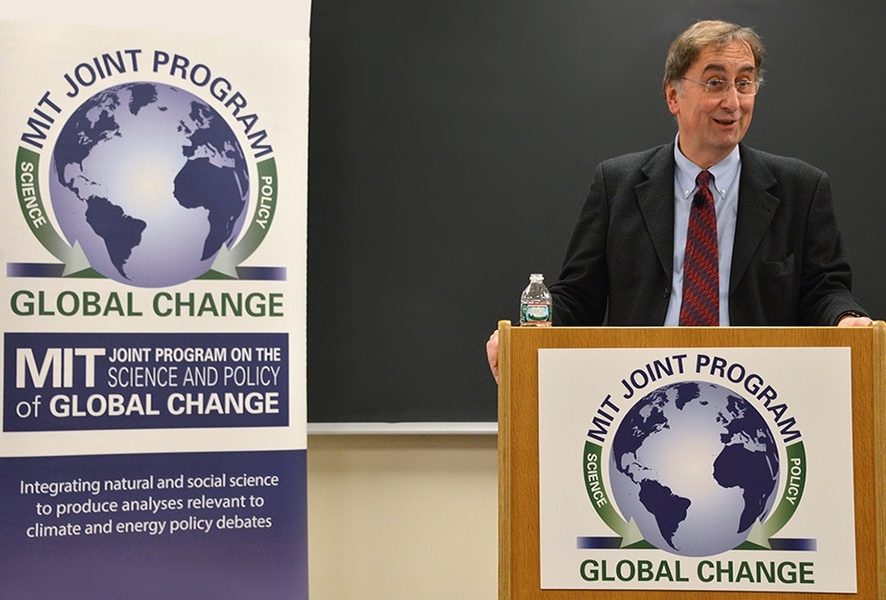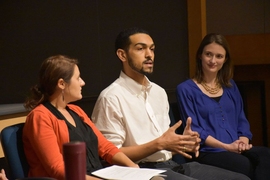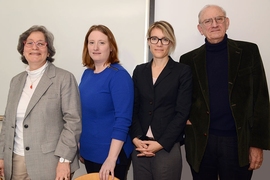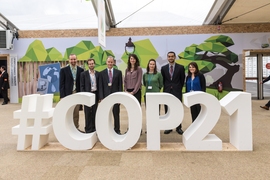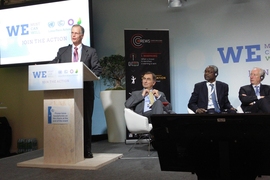Last December international climate negotiations resulted in the Paris Agreement, which aims to cap the rise in average global temperature since preindustrial times at 2 degrees Celsius through substantial reductions in greenhouse gas emissions. Noting that the 188 national commitments at the heart of the pact do not come close to achieving that goal by the end of the century, some critics have voiced skepticism of the pact’s prospects for success. But supporters tout its mechanisms to regularly review and ratchet up national commitments over time and provide sustained financial support to help developing countries fulfill their pledges.
Perhaps the greatest proponent of the Paris Agreement is Janos Pasztor '79 SM '79, senior advisor to the U.N. Secretary-General. Addressing an audience at the Stata Center on Monday, Feb. 29, Pasztor said, “We have an ambitious, universal, and long-term agreement — it defines international support and cooperation, and provides a pathway to being well below 2 degrees. It shows that countries are serious and makes a clear signal to the private sector and to the markets about the direction in which we are going."
Pasztor gave his assessment of the Paris climate talks at a seminar hosted by the MIT Energy Initiative, the first of five daily presentations that he delivered at MIT last week on the history, status, and possible future of international climate change negotiations.
An MIT alum who has spent the past 35 years working for the U.N. and environment-focused non-governmental organizations, Pasztor has been on the front lines of these negotiations from the start. He was there at the 1983 World Commission on Environment and Development, which laid the groundwork for international cooperation on global environmental change; at the 1992 U.N. Conference on Environment and Development (the “Earth Summit”), which established the U.N. Framework Convention on Climate Change (UNFCCC) aimed at reducing greenhouse gas emissions linked to global warming; and at Conferences of the Parties (COP) ever since, where progress on the UNFCCC’s goal has been pursued annually. He has spent most of the past eight years advancing this cause in the office of the U.N. Secretary-General, where he previously served as director of the secretary-general’s climate change support team and assistant secretary-general on climate change.
Making Paris a success
At the Feb. 29 lecture, Pasztor cited two major achievements of the 2015 Paris Agreement: the presence of 150 heads of state at the 21st Conference of the Parties (COP21), and the release by 188 countries of Intended Nationally Determined Contributions (INDCs) outlining specific climate action pledges. Lauding the atmosphere of cooperation, leadership, and readiness for change that prevailed at COP21, he stressed that keeping the rise in global temperature below 2 degrees C will depend on the fulfillment of INDCs through sustained, demonstrable reductions in greenhouse gas emissions.
On Tuesday, March 1, in a talk hosted by the MIT Center for International Studies, Pasztor examined what made the COP21 negotiations such a success. He began by contrasting the Paris climate talks with those held in Copenhagen six years earlier, which he maintained were compromised by four key weaknesses: the imperfect relationship between the host country and the UNFCCC secretariat, the unclear role that the 133 attending heads of state were to play at the conference, inadequate preparation by participating countries, and a weak engagement with the private sector.
“Everyone agrees that [Copenhagen had] a messy ending,” Pasztor said, “but the secretariat and secretary-general’s office learned from this.”
He noted that at COP21, France served as an exceptional partner, working closely with various U.N. bodies and taking early preparations to ensure that the event ran smoothly. Well in advance of negotiations, Secretary-General Ban Ki-Moon met frequently with heads of state, listening to their concerns and championing climate change as a defining issue. And that political capital paid off: by the time the two-week conference concluded, more than 180 countries had submitted national targets and actions, and agreed on binding and non-binding elements of the document. Finally, Pasztor highlighted the “tectonic changes” resulting from the strong presence and deep engagement of the private sector.
Enlisting “non-state actors” to improve outcomes
In a lecture hosted by the MIT Joint Program on the Science and Policy of Global Change on Wednesday, March 2, Pasztor noted that at COP21, businesses, NGOs, and other “non-state actors,” along with national governments, were urged to form partnerships and increase climate action in a process called the Action Agenda. The goal: to launch a virtuous cycle of climate action, where demonstration of action on the ground encourages negotiators to make more ambitious pledges, which, in turn, generate even more action.
Pasztor traced the Action Agenda from its origins — a September 2014 U.N. Climate Summit of government, business, finance, civil society, and local leaders held in New York City that resulted in several shining examples of high-impact, collaborative climate action — to its inclusion in discussions at COP20 in Lima, Peru, to its emergence at COP21 in Paris as a prominent aspect of climate negotiations. At COP21, developments in 12 work streams — on energy efficiency, renewable energy, agriculture, transport, short-lived climate pollutants, forestry, resilience, cities and regions, innovation, buildings, business, and private finance — were presented and discussed in full or half-day meetings that not only demonstrated specific actions on the ground but also produced many new commitments.
“We have collectively managed to achieve a situation where all this incredible action and development that is taking place outside of the negotiation process has now found a way into the negotiation process,” Pasztor said. “I think that’s a very positive development, and we will really see the positive results of this over time.”
On Thursday, March 3, Pasztor discussed climate finance in a lecture hosted by the MIT Center for Finance and Policy. While noting the great strides the U.N. has made in raising funds from governments to support the commitment by developed countries to provide, by 2020, $100 billion per year to help developing countries fulfill their climate action pledges, he cautioned that trillions, not billions, will ultimately be needed to enable the world to shift to low-carbon, climate resilient economies. And that those trillions can only come from the private sector. Toward that end, he described new and innovative vehicles in the public and private sectors designed to better engage investors.
Tapping the power of collective intelligence
On Friday, March 4, in a talk hosted by the MIT Center for Collective Intelligence and the MIT Climate CoLab, Pasztor described the evolution of the UNFCCC process in the 21st century and how it could be enhanced through a collective intelligence approach. Reflecting on his time as assistant secretary-general on climate change, he identified four areas for possible improvement: increasing interconnectivity among U.N. agencies involved in addressing climate change, expanding government engagement, empowering more non-state actors, and making climate change mainstream across U.N. agendas.
Pasztor suggested that the UNFCCC could 1) form closer bonds with other U.N. bodies such as the U.N. Environment Program and the U.N. Development Programme in monitoring and supporting the implementation of INDCs in the Paris Agreement; 2) engage not only the environmental ministers and meteorologists within various governments, but also representatives of other departments in areas such as finance and agriculture; 3) build stronger relationships with financial institutions, energy companies, cities, NGOs, universities and other non-state actors; and 4) deepen the integration of climate change efforts with the U.N. Sustainable Development Goals.
The lecture series was cosponsored by the MIT Center for Collective Intelligence/MIT Climate CoLab, MIT Energy Initiative, MIT Environmental Solutions Initiative, MIT Joint Program on the Science and Policy of Global Change, MIT Office of the Vice President for Research, and MIT Sloan School of Management/MIT Sloan Sustainability Initiative.
Sofia Cardamone (MIT Energy Initiative), Laur Fisher (MIT Center for Collective Intelligence/ Climate CoLab) and Laura Walker (MIT Center for Finance and Policy) contributed to this article.
